K.M. Alexander's Blog, page 34
February 21, 2019
The Best Bookstore
“…the best bookstore would have no genre labels in it at all. That’s absolutely been my aim all along: to get rid of those distinctions.”
As someone who prefers his stories to be a cross-genre, this line really resonated with me. The quote comes from a great little write up from a recent appearance by the man himself where he discussed his work and his time at New Worlds. It’s worth a read.
February 16, 2019
I’m Going to ECCC (Again!)
In less than a month I’ll be attending Emerald City Comic Con for my second year in a row! (Read my Debrief for 2018 here.) Just like last year ECCC ’19 will be more of a work-focused convention. I won’t be running a table or appearing in any panels—the plan is to spend most of my time networking and catching up with some friends and fellow writers.
That doesn’t mean I’ll be a curmudgeon hermiting away in some dark corner. I’ll be sitting in on panels, wandering the show floor, and generally enjoying myself. If you see me—I look like this—please say “hi!” I love to meet up with readers, and it’d be great to chat with you. Don’t be afraid to stop me. As I said last year, I’m as much a fan as I am a writer and I love talking with readers and fellow fans.
View this post on Instagram
February 12, 2019
Raunch Review: Friday
Raunch Reviews is a series about profanity. Not real profanity, but speculative swearing. Authors often try to incorporate original, innovative forms of profanity into our own fantastical works as a way to expand the worlds we build. Sometimes we’re successful. Often we’re not. In this series, I examine the faux-profanity from various works of sci-fi and fantasy, judge their effectiveness, and rate them on an unscientific and purely subjective scale. This is Raunch Reviews, welcome.
[image error]Raunch Review: Friday
The Author: Robert A. Heinlein
Work in Question: Friday
The Profanity: “Slitch”
Heinlein has had his share of fans and detractors, and certainly, Friday isn’t his best-loved book by either group. (A few years ago, Jo Walton wrote a great review for Tor.com, ‘The worst book I love: Robert Heinlein’s Friday,’ which is worth reading.) Within the near-future world of the novel, there a pernicious vulgarity which we’re going to examine today. The word: “slitch.” Regardless of your Heinlein hot-take—something about this vulgarity works too well.
In the novel, the titular Friday —an “Artificial Person” or “AP”— must pass in the near-future world as a human, despite being genetically engineered and possessing mental and physical abilities which far exceed a normal person. There’s a lot of hate and bigotry toward APs. And throughout Friday, we see a world where society is built upon intolerance. In an environment like this, creating a portmanteau like “slitch” fits. (I’ll let you figure out its roots.)
“Slitch” builds off history — twisting and combining a pair of vulgarities we, the reader, recognize while still creating a new word. Its score is slightly held back because understanding its roots require a working knowledge of our modern vulgarities. (We value pure originality here at Raunch Reviews.) But, it feels as icky as its history and its link to the past goes a long way toward creating an effective piece of faux-profanity.
Score: [image error][image error][image error]
 [image error] (4.0)
[image error] (4.0)Previous Raunch Reviews
“Yarbles” from Anthony Burgess’ A Clockwork Orange
“Cuss” from Wes Anderson’s Fantastic Mr. Fox
“Feth” from Dan Abnett’s Gaunt’s Ghosts from Warhammer 40k
“Shazbot” from Garry Marshall’s Mork & Mindy and Dynamix’s Starsiege: Tribes
“Seven Hells” from George R. R. Martin’s A Song of Ice & Fire/Game of Thrones
“Mudblood” from J. K. Rowling’s Harry Potter series
“Frak” from Glen A. Larson’s, Ronald D. Moore’s, & David Eick’s Battlestar Galactica
“Jabber” from China Miéville’s Bas-Lag series
“Storm it”/”Storms”/”Storming” from Brandon Sanderson’s The Stormlight Archives
Have a suggestion for Raunch Reviews? It can be any made up slang word from a book, television show, or movie. You can email me directly with your recommendation or leave a comment below. I’ll need to spend time with the property before I’ll feel confident reviewing it, so give me a little time. I have a lot of books to read.
[image error]
February 7, 2019
Widman: A Free 17th Century Cartography Brush Set for Fantasy Maps
Many engraved maps from the 17th century, especially Italian maps, were heavily inspired by Italian cartographer Cantelli da Vignola and his influence extended throughout lifetimes. In doing map research, I thought it’d be great to look into his impact and from that, I decided it was necessary to build out an enormous set of new free brushes for your fantasy maps. (It’s a sickness, okay.)
Today I’m releasing Widman, a brush set of Italian design named after the engraver. The symbols in this set are pulled from the 1680 Alta Lombardia map of Northern Italy, engraved by Georgio Widman for Giovanni Giacomo de Rossi’s atlas published in 1692. It’s a solid set with a heeeavy focus on mountains (over one-hundred!) as well as a wide variety of forts, villages, cities, and towns.
I find when creating your own map, it’s helpful to have a variety of brushes with subtle differences for each symbol. It adds a hand-made quality to the work. No engraver is perfect, ink bleeds, and the tooth of the paper can affect printing. The quickest way to making a fantasy map look machine-made is the repetition of the same symbol over and over and over. With that in mind, the Widman set is enormous allowing for the subtle differences to help make your map feel more alive and vibrant—it gives the work a human quality.
Inside Widman you’ll find, over 500 brushes, including:
25 Villages
40 Towns
45 Cities
25 Forts
14 Fortified Cities
16 River Crossings
50 Individual Trees
50 Forests
100 Mountains (Hope you like mountains.)
50 Mountain Ranges (As I said.)
42 Hills topped by Settlements
7 Unique Settlements
36 Administration Symbols
Plus More
The button below links to a ZIP file that contains a Photoshop brush set and a transparent PNG in case you’re using a program that doesn’t support Adobe brush files. You can see the transparent PNG here (it’ll come up black if viewed in Chrome, but it’s all there.)
As with all of my brush sets, Widman is free for any use and is distributed with a Creative Commons Attribution 4.0 International License that means you can freely use it in commercial work and distribute adaptations. All I did was convert it to brushes, Georgio Widman did all the heavy lifting—so giving him credit would be fantastic, but it’s absolutely not necessary.
If you like the Widman brush set (or any of my free brushes, really) and would like to support my work, instead of a donation, consider buying one of my weird speculative fiction novels. (The first books is only $2.99 on eBook.) You can find them in stores and online, learn more about the series at bellforgingcycle.com.
I hope you enjoy using Widman, it was a labor of love and I think it’s robust enough to handle all manner of projects and help give your fantasy maps a refreshing and unique edge. Plus that extra connection to history can make a project feel alive. Feel free to show me what you created by sending me an email! I love seeing how this stuff is used and I’d be happy to share your work with my readers.
Want to see the other cartography brush sets I’ve created?
Walser
An 18th Century brush set based on the work of Gabriel Walser with a focus on small farms and ruins and a solid set of mountain and hills. This is a great brush set to see how Vignola’s influence persisted across generations. It was etched over 80 years after the Widman set but you’ll find a few familiar symbols within.
Lumbia
A sketchy style brush set I drew myself that focuses on unique hills and mountains and personal customizability. My attempt at trying to channel the sort of map a barkeep would draw for a band of hearty adventurers. It includes extra-large brushes for extremely high-resolution maps.
Lehmann
Named after Austrian topographer Johann Georg Lehmann creator of the Lehmann hatching system in 1799, this is a path-focused brush set designed for Adobe Illustrator that attempts to captures the hand-drawn style unique 19th Century hachure-style mountains.
 Want to stay in touch with me? Sign up for Dead Drop, my rare and elusive newsletter. Subscribers get news, previews, and notices on my books before anyone else delivered directly to their inbox. I work hard to make sure it’s not spammy and full of interesting and relevant information. SIGN UP TODAY →
Want to stay in touch with me? Sign up for Dead Drop, my rare and elusive newsletter. Subscribers get news, previews, and notices on my books before anyone else delivered directly to their inbox. I work hard to make sure it’s not spammy and full of interesting and relevant information. SIGN UP TODAY →
February 4, 2019
Trip Report – Amsterdam
Amsterdam is a great many things. It is a city with vice, but it is not a city of vice. There’s a difference there. Cities of vice like to plaster their wares everywhere. They write it in neon on the skyline, they shout it from the street corners. Amsterdam, in its old European way, is a bit more subdued about it. But that doesn’t stop people from talking.
“When you mention you’ll be making a stopover in Amsterdam, you get a reaction I can only describe as semi-collegiate. A knowing look… as if there can really only be two reasons you’d go to this lovely little city of canals.”
I feel like I need to get this out of the way immediately. Bourdain was right, mentioning Amsterdam draws all manner of looks and questions. That means diving into Kari-Lise and my trip without discussing Amsterdam’s reputation is difficult. The most significant difference between the Dutch capital and your hometown, is the Dutch are pure capitalists. They organize their vice neatly so it can be taxed and generate money for the state. That’s preferable to the American practice of outlawing it, sweeping it under the rug, and pretending it doesn’t exist until it becomes a problem. The truth is that Amsterdam, for all the illicit happenings, happens to be a diverse, lively, and beautiful little city with a fantastic food scene, tons of culture, and incredible architecture.
On this trip, we were once again joined by our expat compatriots Kelcey Rushing and Jim Rushing. It was Kari-Lise and Kelcey’s birthdays, so we were able to celebrate as we went on a whirlwind exploration of the city. Since this vacation was very city-focused, I’ll share some of the more memorable experiences and hit on the different places we visited throughout our eight-day trip.
Amsterdam
Our canal-side apartment was in Jordaan on the northwest side of the city. It was a twenty-minute walk from nearly everything, and we discovered that it was easy to put six or seven miles behind us throughout the day. Amsterdam—to put it mildly—is beautiful, even in winter. Canals are everywhere. They crisscross the city, cutting beneath roads and emerging between buildings. Amsterdam is extremely walkable, but if you want to get out of the rain, you’ll usually find a tram that passes by your destination. I could spend days walking in the city — each corner offers a new vista, and discovering the nooks and crannies was enticing.
[image error]One of the nearby canals in Jordaan.
Amsterdamers are diverse, friendly, and welcoming. The food culture is fantastic, with a ton of street food, from the traditional cone-of-frites with hefty helpings of mayonnaise to automats tucked away on the street level of four-hundred-year-old buildings. If you want something fancier, you can find plenty of that as well: I’d recommend checking out Lion Noir on the south side of the canal belt or Springaren toward the north.
Make sure you swing through an Indonesian restaurant or two — due to the Dutch East India Company’s colonization in the 1800s, there’s a significant presence of Indonesian and Surinamese people within the city. This influx brought Southeast Asian cuisine to the Dutch, which led to the creation of Rijsttafel—a large family-style meal consisting of small spicy dishes served with rice. It’s a delicious experience and well worth trying.
[image error]Our adorable apartment in Jordaan
Over the next several days, we hit up a few of the more traditional museums to fill our quota of Dutch art. (Those Rembrandts aren’t going to view themselves!) But, since we’re Atlas Obscura disciples, we also tend to seek out the strange. Before our trip, I quickly assessed the weirder side of Amsterdam. You tend to find a lot of odd little bits in a city this old, and Amsterdam is packed full of curiosities. We explored a museum of cat art, had high tea in the smallest house in Amsterdam, visited a collection of odd and esoteric books, found a Catholic “house church” hiding in the upper levels of a 17th century canal home, and we took a morning to spend some time looking through a collection of anatomical anatomy and congenital defects on the outskirts of the city. Even with all of that, I felt like we had only scratched the surface.
It’s easy to see how there are whole swaths of the city we missed. Which means there are so many more places to explore. Amsterdam will be a perfect pit stop for a few days whenever we return to the Continent.
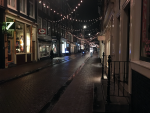
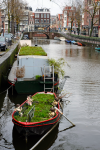


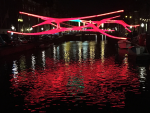

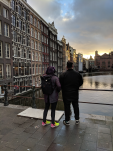
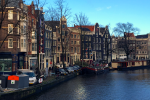

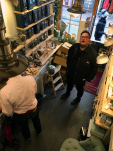
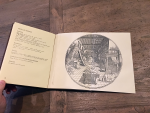
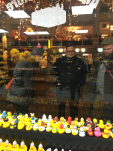

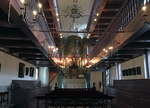
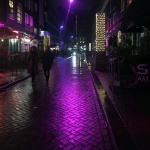
Bruges & Haarlem
The last three days of our trip was spent outside of Amsterdam. On the Rushing’s suggestion, we rented a car and made the two-and-a-half-hour drive down to Belgium, with Bruges as our destination. The Netherland and Belgian landscapes are vast and flat; huge windmills turn in the distance and hydroponic farms line the ancient canals, open fields, and miles upon miles of greenhouses. The Netherlands have become agricultural giants, and you can see it in the countryside.
[image error]Kari-Lise, myself, and Jim walking down a quiet street in Bruges – Photo by Kelcey Rushing
We arrived in Bruges by mid-afternoon. The city, with its narrow streets and canals, is an Amsterdam in miniature. But where Amsterdam didn’t see life until the 13th Century, Bruges has been settled since the 9th Century. So its buildings tend to be older than those you’d find in Amsterdam, with a few dating from medieval periods.
Being a Belgian town, chocolates glisten from shop windows, waffles are available on street corners, and pommes frites served in paper cones are as ordinary here as they are in the Netherlands. Also with it being Belgian, it’s no surprise that Bruges has a great beer scene! Many beer cellars peddle Belgian ales beneath the ancient buildings. Kelcey and Jim had a few picks from their previous visits. My favorite was ‘t Poatersgat (The Monk’s Hole) who specialized in only independent Belgian brews—with a focus on Trappist beers—many of which are unavailable outside of the country. It’s located in the vast cellar of an old building and accessible by a tiny door that leads down into the hall. The place has a feeling of a cistern or catacomb. A great vibe with reasonable prices, and a friendly and helpful staff.
[image error]Kari-Lise and the canals of Bruges
Sadly, we didn’t get to spend much time in Bruges. But I was glad I went: I could see the appeal, and I’d certainly make a return visit. We drove north to Haarlem on the final full day of our trip skirting the coast and seeing the vast Oosterscheldekering waterworks. It’s an impressive feat of engineering.
Haarlem is a small city to the northwest of Amsterdam, with a relaxed vibe. It’s a bit slower paced than the frenetic energy of the capital and quieter than the destination town of Bruges. It was a relaxing way to end a fast-paced trip such as this; and with easy access to Amsterdam, it’s not a bad place to stay if you want quiet nights away from the hustle and bustle. The following morning, after breakfast and a wander through a farmer’s market, we headed to Schipol and then made our way home.
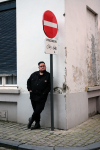
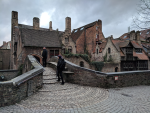
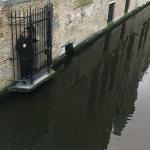
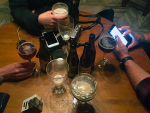


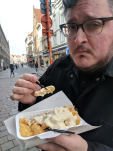
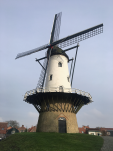
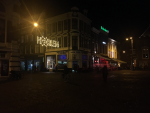

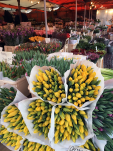
Advice & Tips
If Amsterdam sounds like your sort of place, I do have a few bits of advice:
Scope out the weirdness on Atlas Obscura . (Heck, do this for every trip you take.) It’s a great resource and is usually full of non-touristy stuff that is worth checking out.
Get thyself an Amsterdam City Card . We didn’t do this, and it would have saved us some money on trams and museums. It also makes it even easier to get around.
Hit up Eater’s recommendations for Amsterdam food. We found a lot of great restaurants this way, and mapped them out ahead of time. This made it simple to pull up ideas when we needed them.
If you’re a hearty traveler who doesn’t mind chilly weather, you can score super cheap tickets to Europe in the offseason. It’s worth exploring prices in October/November to see what you can find in January/February. By all accounts, summer in Amsterdam is quite crowded. Our off-season travel meant finding tables and seats were easy. Something to consider.
Amsterdam was a wonderful experience, and I will certainly be going back. It should be a destination city for everyone. There is a massive amount of things to do, see, and eat. We could have easily spent another week among the canals and even with extra time, I doubt we’d have exhausted the city.
Thanks again to Kelcey and Jim for joining us on the trip, and being willing to bum around the town. Amsterdam is one of their favorites — they had been many times before, and are gracious enough to indulge our bright-eyed wonder. It was a lot of fun. (I told you after Scotland they’d show up on future trips!)
“The traveler sees what he sees, the tourist sees what he has come to see.”
Travel is important. It’s important for understanding other cultures. It’s important for fully grasping the weight of history. It’s important for understanding others. We’re lucky to live in an era when traveling around the world is easy and reasonably accessible. It lets us experience how others live in a physical way. Losing oneself within another culture helps build empathy and open up new perspectives extending beyond our own narrow silos.
As a writer, it’s important to acknowledge that we live in a world of stories. Exploring the narrow alleyways or deep canals of a city can reveal ideas. We can find new characters lingering beneath street lamps on remote corners and hiding in doorways down tight alleys. It’s common to stumble across plots etched in architecture, history, or the twisting street plans of an ancient city. Ideas, concepts, and characters we might not have discovered sitting at home. So, get out there. Travel. Meet people. Listen to them. Be humble and get uncomfortable.
As I write this, it’s been over a week since our trip, and we’re getting back into our routine. I’ve settled back into work, and I’ve dived back into writing. The pages of Gleam Upon the Waves won’t write themselves, and there’s a specific caravan master who’s in a bit of a jam. Time to travel back to the Territories and see where his story leads.
 Want to stay in touch with me? Sign up for Dead Drop, my rare and elusive newsletter. Subscribers get news, previews, and notices on my books before anyone else delivered directly to their inbox. I work hard to make sure it’s not spammy and full of interesting and relevant information. SIGN UP TODAY →
Want to stay in touch with me? Sign up for Dead Drop, my rare and elusive newsletter. Subscribers get news, previews, and notices on my books before anyone else delivered directly to their inbox. I work hard to make sure it’s not spammy and full of interesting and relevant information. SIGN UP TODAY →
February 1, 2019
A Video Tour Inside Roald Dahl’s Writing “Hut”
Today Boing Boing shared this great interview/documentary with Roald Dahl from 1982—one where he gives a little tour of his writing “hut,” shares insight into his interests, and talks about his daily routine. After watching, I knew I had to share it here as well. I’ve always been fascinated by other writer’s spaces and routines I think where and how we work—be it a shed, a hut, a home office, a coffee shop, or a nook—says a lot about us as creators.
If you want to know more about Dahl’s hut, there’s a great article from the BBC that details it even further. Apparently, it was inspired by Welsh poet Dylan Thomas’ own space which is also detailed in the piece. It’s worth checking out.
Dahl’s hut is now apart of the Roald Dahl Museum in Great Missenden, England.
January 23, 2019
Forget Inspiration
“First forget inspiration. Habit is more dependable. Habit will sustain you whether you’re inspired or not. Habit will help you finish and polish your stories. Inspiration won’t. Habit is persistence in practice.”
Hey, I’m back! I’ll have a trip report coming soon, along with more Raunch Reviews and a few new brush sets for your fantasy maps. Oh, and I’m still plugging away at Gleam Upon the Waves. I think you’re going to like it.
January 10, 2019
A Brief Hiatus
For the next week or so, things around here will slow down a bit as I intentionally go internet-silent. Responses to emails and comments will be delayed during that time. Kari-Lise and I are traveling to Amsterdam and Belgium for her birthday and meeting up with our travel pals, Kelcey and Jim. (The same fine folks who joined us in Scotland.) I might occasionally post to Instagram, so I do recommend following me if you’re interested in my travels. I’ll assemble a trip report upon my return!
My current plan is to resume normal blog activities around late-January. But, if you’re looking for something to read in the interim, here are a few of my more popular posts:
Your Fave is Problematic—That’s Okay
Walser: A Free 18th Century Cartography Brush Set for Fantasy Maps
Mapping Resources for Authors (and GMs)
Riverboats at War
Raunch Review: A Clockwork Orange
My Reading List for 2018
A Riverboat’s Demise
How Passenger Airships Worked
Hunting The Yellow Sign
Raunch Reviews: Warhammer 40k
See y’all in a week or so!
January 7, 2019
Walser: A Free 18th Century Cartography Brush Set for Fantasy Maps
I was doing some research on Switzerland and looking at old maps when I came across a 1763 map of Canton Lucern created by Gabriel Walser. I found myself inspired by all his details, especially those focusing on the cities, towns, and parishes. It’s still stunning 250 years later and it’s an amazing time capsule. You can see the influence into more modern designs and the connections to older styles. As I was looking, I realized it’d make an excellent set of brushes for fantastical maps, especially for those artists (like me) who like to ground their work with a historical approach.
So, I spent a Saturday converting all sorts of objects in the map into brushes and today I am releasing it as Walser, an 18th Century Cartography Brush Set for Photoshop taken from Gabriel Walser’s original work. The set is enormous—over 250 brushes, to help make your projects unique. Having different images for the same object helps make your map feel more hand-drawn. No artist can hand-render the same object identically—even printing presses aren’t perfect no matter how hard they try. Adding subtle variants can help trick a reader’s eye and it makes a map feel more authentic.
[image error] A tiny fraction of the brushes included in Walser
I like working with a lot of brushes and Walser is big (see the full set here), all of the settlement’s names I took from the original German key (thanks to my friend Redd for helping translate)—Walser had a particular way of labeling ruins that I enjoy. Inside the set you’ll find:
5 Large Cities
10 Castles
10 Towns
10 Catholic Parishes (They look like towns but with little crosses on top. Consider swapping those for a religious icon from your setting.)
10 Monasteries
10 Chapels
20 Scattered Farms
10 Ruins
30 Individual Trees
30 Blocks of Trees
40 Hills
30 Mountains
15 Mountain Ranges (aka jagged hills)
22 Unique/Combination Landforms
The button below links to a ZIP file that contains a Photoshop brush set and a transparent PNG in case you’re using a program that doesn’t support Adobe brush files.
Wasler is free for any use and is distributed with a Creative Commons Attribution 4.0 International License that means you can freely use it in commercial work and distribute adaptations. All I did was convert it to brushes, Wasler did all the heavy lifting—so giving him credit would be fantastic, but it’s absolutely not necessary.
If you like the Walser brush set and would like to support my work, instead of a donation, consider buying one of my urban fantasy novels. (The first books is only $2.99 on eBook.) You can find them in stores and online, learn more about the series at bellforgingcycle.com.
Enjoy Walser! It’s a great little set to make maps and connect with history. There’s a lot of incredible cartographers and geographers throughout history that should be remembered and it’s important we enthusiasts take moments to reflect on their impact. Gabriel Walser has a few other maps as well and his style varied, which has me thinking about a Wasler supplement for the future. Finally, feel free to show me what you created by sending me an email! I love seeing how this stuff is used and sharing your work with my readers.
Want to see the other cartography brush sets I’ve created?
Lumbia
A sketchy style brush set I drew myself that focuses on unique hills and mountains and personal customizability. My attempt at trying to channel the sort of map a barkeep would draw for a band of hearty adventurers.
Lehmann
Named after Austrian topographer Johann Georg Lehmann creator of the Lehmann hatching system in 1799, this is a path-focused brush set designed for Adobe Illustrator captures the hand-drawn style unique 19th Century hachure style mountains.
 Want to stay in touch with me? Sign up for Dead Drop, my rare and elusive newsletter. Subscribers get news, previews, and notices on my books before anyone else delivered directly to their inbox. I work hard to make sure it’s not spammy and full of interesting and relevant information. SIGN UP TODAY →
Want to stay in touch with me? Sign up for Dead Drop, my rare and elusive newsletter. Subscribers get news, previews, and notices on my books before anyone else delivered directly to their inbox. I work hard to make sure it’s not spammy and full of interesting and relevant information. SIGN UP TODAY →
January 6, 2019
Death of the Author
I initially saw this posted over on Scalzi’s blog—but didn’t get a chance to watch it until last night. I recommend reading John’s thoughts on the video as well (Linked above.)
It’s no secret I’m a big fan of Lindsey Ellis’ work—and I thought she did an excellent job tackling Roland Barthes’ La mort de l’auteur and the concept/dialog surrounding authorial intent as a whole. I particularly like the focus on authors working in today’s brand-focused social media-driven world. It’s very much worth a watch.




